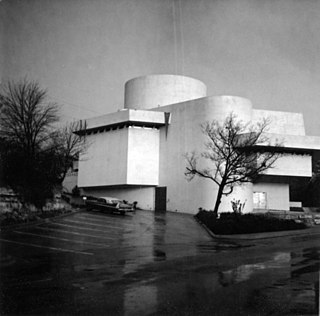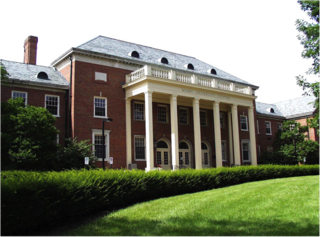
Lincoln Center for the Performing Arts is a 16.3-acre (6.6-hectare) complex of buildings in the Lincoln Square neighborhood on the Upper West Side of Manhattan. It has thirty indoor and outdoor facilities and is host to 5 million visitors annually. It houses internationally renowned performing arts organizations including the New York Philharmonic, the Metropolitan Opera, the New York City Ballet, the Chamber Music Society of Lincoln Center and the Juilliard School.

The Shanghai Grand Theatre is a complex located at the intersection of Renmin Avenue and Huangpi North Road in the northern part of the People's Square in the Huangpu District of Shanghai. The building houses the Shanghai Opera House and other performing companies.

Indiana University South Bend is a public university in South Bend, Indiana. It is the third largest and northernmost campus of Indiana University.
The Ferguson Center for the Arts is a theater and concert hall on the campus of Christopher Newport University in Newport News, Virginia, United States. The complex fully opened in September 2005 with two concert halls and many other facilities.

Powell Hall is the home of the St. Louis Symphony. Erected in 1925 as the St. Louis Theatre, the theatre presented live vaudeville and motion pictures. The theatre was acquired by the St. Louis Symphony Society in 1966 and renamed Powell Symphony Hall after Walter S. Powell, a local St. Louis businessman, whose widow donated $1 million towards the purchase and use of this hall by the symphony. The hall seats 2,683.
The Broward Center for the Performing Arts is a large multi-venue performing arts center located in downtown Fort Lauderdale, Florida, United States.

The Donna & Marvin Schwartz Center for Performing Arts is a 90,000-square-foot (8,400 m2) multi-discipline performing arts facility on the campus of Emory University in Atlanta, Georgia. Completed in early 2003, the Schwartz Center provides a multidisciplinary teaching and performance center for the performing arts programs at Emory including dance, music, and theater. The centerpiece of the center is the 825-seat Cherry Logan Emerson Concert Hall featuring a custom-built Daniel Jaeckel Opus 45 pipe organ with fifty-four stops and 3,605 pipes in a cherry-wood case. The concert hall was designed in part by renowned acousticians Kirkegaard and Associates. The $36.9 million structure was designed by lead architect Michael Dennis in association with Howard-Montgomery-Steger and Smallwood, Reynolds, Stewart, Stewart.

The Tulsa Performing Arts Center, or Tulsa PAC, is a performing arts venue in the city of Tulsa, Oklahoma. It houses four main theatres, a studio space, an art gallery and a sizeable reception hall. Its largest theater is the 2,365-seat Chapman Music Hall. The Center regularly hosts events by 14 local performance groups. Tulsa Ballet, Tulsa Opera, Tulsa Symphony, and Celebrity Attractions are among the Tulsa PAC's major clients. Tulsa Town Hall, Chamber Music Tulsa, Theatre Tulsa, American Theatre Company, Theatre Pops, Playhouse Tulsa, Theatre North, and the PAC Trust also fill the PAC calendar.

The Peoria Center for the Performing Arts is a community theater and event space located in the historic Old Town district of Peoria, Arizona. The building houses two theaters. The venue was completed and a dedication ceremony was held on December 15, 2006 as a joint venture with the City of Peoria and the theater company, Theater Works, who operates the building. The center would not officially open until February 2007 after Theater Works had moved in.

The Helene Zelazo Center for the Performing Arts is a performing arts center located on the campus of the University of Wisconsin–Milwaukee. It houses the 756-seat Helen Bader Concert Hall, large rehearsal spaces, meeting facilities, music offices, and dance studios for the UWM Peck School of the Arts. The Zelazo Center is one of many facilities maintained by the Peck School of the Arts, including the Fine Arts Building, as well as Kenilworth Square East.

The Kalita Humphreys Theater is a historic theater in Dallas, Texas (USA). It is the only theater by architect Frank Lloyd Wright and one of the last completed buildings he designed. It was built in 1959 for Dallas Theater Center who still produces original productions on the revolving stage.

The Shriver Center, located at Miami University in Oxford, Ohio, USA, was first opened as the University Center in 1958. Later it was renamed as the Phillip R. Shriver Center, and provided space for not just the student body at the university, but also for faculty, staff and the greater Oxford community.

Fisher Hall was a building at Miami University in Oxford, Ohio. Originally the Oxford Female College, the building was later used as a sanitarium and was purchased by Miami in 1925. It served as a first-year men's residence hall, Naval training school, and theatre. The building remained in use as a dormitory until 1958, when the upper floors were condemned and the theatre remained the only part of the building still in use. With the construction of Miami's Center for Performing Arts in 1968, the theatre became unused and the building turned into a storage facility. After a push to save the building in the mid-1970s, the hall was razed because the cost of renovating the building was identical to the costs of new construction. Miami University's hotel, The Marcum, was built in 1982 on the former site of Fisher Hall.

Alumni Hall, formerly known as Alumni Library, is an academic building at Miami University in Oxford, Ohio. It currently houses the university's Department of Architecture and Interior Design and the Wertz Art and Architecture Library. A Lombardic Romanesque building, Alumni Hall was built in 1910 and was funded by the Carnegie Corporation of New York.

Pearson Hall is the biological science building at Miami University in Oxford, Ohio. The building was originally known as The Biological Science Building, but was renamed Pearson Hall as a dedication to Miami's 18th President. Prior to being a building, the area where Pearson Hall stands now was known as Miami Field, Miami University's original athletic field. The building caters to a wide range of different science departments including ecology, genetics, biology, and neuroscience. Some of the notable features of Pearson Hall are its Electron Microscope Facility and the Animal Care Facility. Pearson Hall also is home to two large aquatic Animal rooms used to replicate oceanic and freshwater environments. Another feature of Pearson is its instruments in the environmental and ecological toxicology department, which enables an array of different testing's and analysis to be conducted within the building. The Behavioral ecology department has a special laboratory used for hormonal analysis and behavioral testing. The entomology department contains an insect collection of over 82,000 specimens.

Withrow Hall is a dormitory and former gymnasium at Miami University in Oxford, Ohio. Under the name Withrow Court, the men's gymnasium was constructed in 1932 and was Miami's main athletic facility until the construction of Millett Hall in 1968. The building was repurposed as a dormitory in 2016, opening to students in the fall of 2018 under the new name of Withrow Hall. The building also housed the University Archives until its merger with the main library in 2016.

Culler Hall was a classroom building at Miami University in Oxford, Ohio. Its construction was completed in 1961. With the dedication of Culler Hall on Sunday, January 29, 1961, John B. Whitlock presented Culler Hall as a new building with classrooms and laboratories dedicated to the study of mathematics, physics, and aeronautics. Built from 1959 to 1961, Culler Hall construction warranted the cutting down of around 60 trees. The clearing of these trees led to the creation of the protected Bishop Woods. In October 1957, then president of Miami University, Dr. John D. Millett, contacted architects from Cellarius and Hilmer Architects to estimate the cost of adding air-conditioning into Culler Hall during its creation. This warranted 8 inches more for each floor, creating a necessary amount of about $43,000 more for the project. The center of the U-shaped structure had an impressive glass front entrance showing off the Foucault Pendulum within.

MacCracken Hall is a women's residence hall on Miami University's campus in Oxford, Ohio. It is named after Miami Graduate Henry Mitchell MacCracken. It is located on Miami University's Central Quad, and currently houses four sorority chapters: Alpha Chi Omega, Chi Omega, Kappa Alpha Theta, and Kappa Delta.

The Cultural Center of the Philippines Complex, also known as the CCP Complex, is an 88-hectare (220-acre) art district managed by the Cultural Center of the Philippines (CCP) located along Roxas Boulevard in Metro Manila, Philippines. It is a mixed-use cultural and tourism hub overlooking Manila Bay in south-central Manila, most of which fall under the jurisdiction of the city of Pasay.
Northern Vermont University (NVU) was a public university in Johnson and Lyndon, Vermont. It was established in 2018 by the unification of the former Johnson State College and Lyndon State College. The university offered over 50 Bachelor's degree programs and Master's degree programs. On July 1, 2023, its two locations became campuses of the newly formed Vermont State University.





















